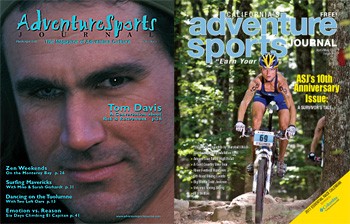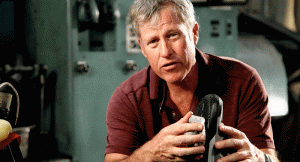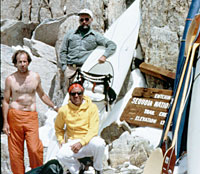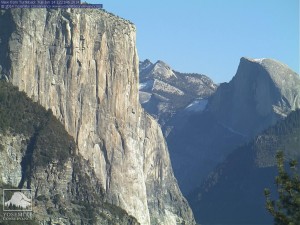- Paddling My Own Canoe - 10/01/2018
- West Coast Board Riders Club - 10/01/2018
- Never Too Oldfor Gold - 07/29/2018
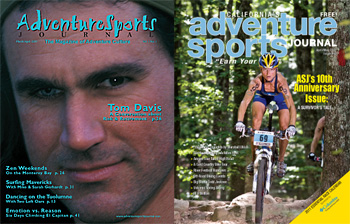 10 years of Adventure Sports Journal
10 years of Adventure Sports Journal
Ten years ago Adventure Sports Journal was inspired by a Sierra climbing trip gone bad. Matt Niswonger and Cathy Claesson were a husband and wife team off route, lost, cold and hungry. But they pulled together, solved one problem at a time, and made it back to Highway 120, albeit miles from where they parked.
By the time they got back to the car the frustration turned to sheer joy. As they drove home the climbing experience crystallized into an epiphany about the magic of such “deep play” in the Sierra. One could do worse than to devote one’s life to such matters. Why not this quirky husband and wife team? Teachers by trade, how could they live closer to the richness of such adventures?
On the car ride home, Matt convinced Cathy that they should start a magazine that would offer a unique forum for other adventure enthusiasts in California to share their own stories of adventure, hellish or not. Traditional media at the time rarely covered nature-based outdoor sports with the possible exception of skiing. This new magazine intended to fill that void.
They settled on a name, put a mock issue together, and thought they were in business. Little did they know there is a lot more to publishing then a masthead and boundless enthusiasm. Media kits, demographic studies, CPM’s, printer contracts, distribution routes — the mysteries were many and they needed help. They took on an editor, Christa Fraser, as a partner and got some tentative advertising contracts with local businesses.
Nearly eight months later, 7,000 copies of the inaugural issue of Adventure Sports Journal were spread around Northern California from the back of a couple of barely running station wagons. It was truly a grassroots effort.
Since then, ASJ has become a favorite resource for a diverse and dispersed yet thriving outdoor sports and adventure community in California and Nevada. With a mission to provide the inspiration and beta for our readers to get out and enjoy all that our regional landscape has to offer, ASJ has strived to highlight the year-round adventure opportunities that make California and the West one of the richest regions in the world to live and play. After all, where else can you be skiing in the morning and surfing at sunset?
To commemorate our 10-year anniversary, we’ve compiled some of the highlights from our past issues stretching back to 2001. We hope that those of you who have been reading ASJ for years will remember some of the articles we’ve selected. And for those of you who are turning the pages for the first time, we hope that the excerpts that follow inspire you to get out on you own adventures — and to pick up future issues of what has grown into the top adventure sports magazine in California.
—The Editors
| 2001 |
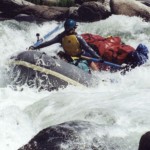
March/April, #1
“I frantically jumped up and down, knowing that because of where I was stuck, no one could easily help me. The rocks below, with water rooster tailing and surging off of them, made for a painful swim. I looked at the rest of the rapid; it was just as challenging and dangerous as the falls. I couldn’t possibly make it through that even if I was able to get the boat unstuck.”
—Christa Fraser on rowing a fully loaded oar boat through Clavey Falls on the lower Tuolumne River
“Growing up I was really into superheroes. When I discovered climbing I was like, ‘Cool, this is a superhero sport.’”
—from the article “Risk and Retirement: A Conversation with Tom Davis.” Davis is an avid Yosemite rock hound and owner of the Pacific Edge Climbing Gym in Santa Cruz
May/June, #2
“My eyes shifted suddenly to the right and I saw a huge fin breaking the water through the second swell and the outline of a massive, grey animal coming straight toward me. Somehow, for reasons I can’t really explain, my mind refused to acknowledge what I had just seen. It just didn’t register that it was a shark.”
—Casey Stewman on his encounter with a great white
“Don’t get me wrong. I love powder. I have been skiing for a lot of years. But when the powder is a three-inch thick layer of ultra fine dirt that offers no purchase for a cross-country mountain bike, anyone might feel challenged.”
—Sarah Stout on her first lift-served biking experience at Northstar in Tahoe
July/August, #3
“The steep rocky slope of the drop off disappeared into the depths. Untold mysteries lurked below. A nearby lake was known to be 600 feet deep. Thus, relative to its size, Tulainyo could have been twice that depth. We were overwhelmed by the sense of endless space.”
—Peter Hemming on diving Lake Tulainyo in the Eastern Sierra. At 12,818 feet, it’s the highest lake in the continental U.S.
September/October, #4
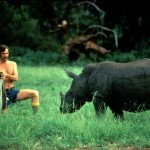
Photo: David Miln Smith’s Collection
“I remember climbers coming up to me in Yosemite and saying something like, ‘We’re not into commercialized competition, man.’ Once people got wind of the $15,000 purse for first prize, though, all the philosophical reservations just kind of evaporated.”
—David Miln Smith on getting athletes for NBC’s “Survival of The Fittest” TV series
November/December, #5
“The discovery of Mavericks in the backyard of hard-core Northern California surf territory was somewhat like finding the Loch Ness monster in San Francisco Bay – somehow undiscovered all these years, yet always right beneath our nose.”
—Krista Hammond on the once unheard of Mavericks surf break
“Tragically, Dano was killed in November 1998 while breaking his own record for roped free-falling. The news was shocking. Of course, nobody questioned that the stuff he did was dangerous, he just seemed to be surrounded by a special light that kept him safe from harm.”
—Matt Niswonger on rock climber Dan Osman who died at age 35 while performing a “controlled free fall” from Yosemite’s Bridalveil Falls
| 2002 |
January/February, #6
“I sold my belongings and moved to Alaska to learn the wilderness skills I would need to take a dog mushing journey to Antarctica. Call it escapism, call it denial, call it crazy—but I was determined to try.”
—Pam Flowers on her decision to quit her “normal” life and solo the Arctic by dogsled
March/April, #7
“Yet risk will always be at the frontier in climbing. As people like Chris define what’s possible from a strictly physical standpoint, in the future climbers will take Sharma-like sequences to the big faces of the world.”
—Matt Niswonger on Chirs Sharma and his influence on the sport of climbing.
May/June, #8
“Advocating strength and redemption from the humiliation of World War I, the newly elected Nazi party threw unprecedented sums of money at Willy Merkl’s proposed 1934 assault on the world’s tenth highest peak. For Merkl, a mediocre climber and a railway engineer, the funding was a dream come true, but at a price: the pressure to succeed was intense and came from high up, probably from Hitler himself.”
—Matt Niswonger on the 1934 Nazi attempt on Nanga Parbat
July/August, #9
“For his second expedition down the Grand Canyon, one-armed John Wesley Powell strapped an armchair atop a wooden dory, which he named the Emma Dean, and read Sir Walter Scott’s Lady of the Lake out loud to his men.”
—Christa Fraser on John Wesley Powell’s first descents down the Grand Canyon in 1869 and 1871
September/October, #10
“To give you an idea of just how civilized McMurdo is, I had just arrived in town, an F.N.G (f-ing new guy). I was walking down the main hallway and then I stopped. Jaw dropping, I turned and recognized a Wells Fargo ATM. Yes, an ATM.”
—Matt Rutishauer on living at McMurdo Station while ice diving in the Antarctic for marine research
“As the wind howls, the Taugwalders and Whymper stare at the severed rope in despair. Whympher gathers himself first. He tells the Taugwalders that they will die, too, if they don’t pull themselves together.”
—Looking back at Edward Whympher and his tragic quest to summit
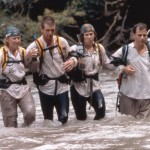
the Matterhorn in 1864
November/December, #11
“Many people in our society want to be somewhere else rather than where they are in their lives. They remain in the “can nots” and the “should nots” and the “what ifs” of everyday life until one day they wake up and realize that they’ve lived in that “did not” world for over 40 years.”
—Terri Schneider on adventure racing
“Immediately, we’re in trouble. First up are 12 miles of roller blading—our weakest event. Karen already has a wound the size of a small pizza on her leg from a spill she took during a last-minute training session and Chris just isn’t comfortable with wheels strapped to his feet. Our goal at this point is modest: stay out of last place.”
—Jordan Reiss’ experience in an urban adventure race
| 2003 |
January/February, #12
“I expected the trip to be long and hard, and I wasn’t disappointed. There were some moments when I felt certain that the ride was by far the most stupid-ass idea that I had ever attempted in my life, and I had no idea how I was going to make it out the other side.”
—Sarah Beaver on her 2,987-mile southern transcontinental bike ride from California to South Carolina
“We start to rope up. Nima goes off belay to clip Evan in and – vanishes. Magid, who saw it, says he fell on his back and was flying head first down the lip toward the face. What I saw was the fastest self-arrest in history and one of the biggest smiles – he stopped about ten feet from me.”
—YOSAR team member Michael Freeman off-duty on Khumbu in Nepal
March/April, #13
“As we scraped across every rock on that ‘non-paved’ road at 15 miles an hour, my anger growing with each dent in the oil pan, I made a solemn promise to myself: The next time I drove into Baja it would be in a big, bad-ass, 4-wheel drive truck.”
—Krista Hammond deep in the Baja desert searching for surf
“Time took on a more circular meaning on the river. At put-in I hid my watch for the duration of the trip.”
—Daniel Spero on rafting the Colorado River through the Grand Canyon
May/June, #14
“Twenty days is a long time to be alone aboard a boat whose cabin is smaller than a VW bus, and standing headroom is not an option.”
—Skip Allan describes his living quarters while sailing 2000 miles from San Francisco to Oahu in the 2002 West Marine Pacific Cup Race
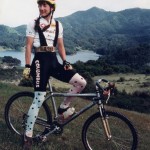
Photo: Dave Stewart
“Dealing with fear has been a big part of my return to climbing. My biggest struggle has been conditioning my mind to believe that I can climb hard again.”
—Peter Carrick on getting back into climbing after being struck by lightning on a climb in Utah
July/August, #15
“It was fun – a bunch of chicks in the woods riding all day, trying out our new chops, then cooking and eating massive amounts of pasta, talking non-stop story and a little smack.”
— Jacquie Phelan talks about the early days of professional mountain biking with writer Ramona d’Viola
“I couldn’t deploy my parachute, since deployment kills all forward speed and immediately uses up about 100 vertical feet.”
—Wingsuit daredevil Rob Kelly has a close call while flying past a granite stone cap
September/October, #16
“The birthplace of surfing is Hawaii, but it took a Californian to bring the sport into the modern age.”
—Krista Hammond on the evolution of surfing
“OK, let’s really make it interesting. Let’s run as tight a schedule as possible and plan the road trip down to the minute with absolutely NO room for errors.”
—Paul Romero of Team Epi-SOLE planning his trip to the starting line of Cal Eco’s 24-hour adventure race in Yosemite
November/December, #17
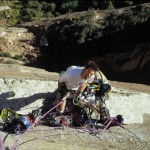
Photo: Chris Falkenstein
“Eric also stumbled off of our bivy ledge while attempting to turn over the tape in the player while I was making dinner. I wasn’t tied in due to the comfortable size of the ledge, so I assumed he wasn’t either. All I saw when I leaned over the ledge was a headlamp falling to the ground. I thought Eric was attached to it. A dreadful feeling came over me for a moment. I thought to myself, ‘I finally get a great partner and he falls off the route while drunk. Great.’”
—Eric Rasmussen reflects on some of his wild adventures in Yosemite Valley
“At one point I was slightly maddened by having my clothes on, so I ripped them off in a village and tossed them in the garbage.”
—Overdressed in Borneo, Terri Schneider takes it off while racing in the Eco Challenge
| 2004 |
January/February, #18
“Brad and Bob were nearly mad with hunger. Somewhere along this stretch of the journey they were able to catch and kill a small squirrel.”
—Brad Washburn’s near fatal experience while climbing Mt. Lucania in the Yukon
“There is a reason that early Homo Erectus didn’t dive – he wanted to survive. Fortunately, the first part of learning to dive appeals to our modern brain. Otherwise, my inner Neanderthal would have hightailed it out of there pretty quickly.”
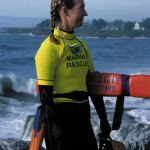
—Editor Christa Fraser learns how to dive
March/April, #19
“These are all things we train for: big surf, winter conditions, low light, victims near rocks. But in 12 years of lifeguarding never have I worked under all of these conditions at once.”
—Lifeguard Haven Livingston, pushed to the limit when unprecedented surf required rescuers to save multiple victims up and down the Santa Cruz coast
May/June, #20
“After his accelerated climb up Half Dome, Florine ran down the cables on the backside to the valley floor and bought an ice cream bar. On his hike to the base of El Cap, Florine ran into his friend Steve Schneider, who told him that just 24 hours earlier well-known speed climber Dean Potter had come to Yosemite to do the “Big Linkup” before him.”
—Speed climbers Hans Florine and Dean Potter race to be the first to complete the “Big Linkup,” a solo ascent of both the face of Half Dome and El Capitan’s Nose in one day
“Back at camp, we beam with satisfaction and physical relief, and celebrate with a backcountry potluck dinner (cook whatever you have, pass the pot around with a couple of spoons in it, return, cook, pass…), ibuprofen, great stories, and laughter about hairy situations and shared discomforts.”
—Editor Pete Gauvin after a treacherous day of climbing and skiing Shasta’s Hotlum-Wintun route
July/August, #21
“Like many epic ideas that take hold of our imagination, the Death Ride was born out of the same illogical desire that possess people to climb big mountains – because they can, maybe.”
—Pete Gauvin on the birth of one of California’s most difficult single-day events, The Death Ride: Tour of the California Alps, 129 miles, five passes and 16,000 feet of climbing
September/October, #22
“But the ‘Ray Way’ is much more than cutting the handle off your tooth brush. And it is certainly not about rushing out to buy the latest in ultralight gear. On a deeper lever, it is more about overcoming the commercially promulgated view of nature as an adversary that one must continually prepare to do battle against and adopting a more rhythmic, harmonious approach to backcountry travel.”
—Pete Gauvin on Ray Jardine and the revolution of lightweight wilderness travel
“We did absolutely nothing. A fascinated curiosity dampened our protective impulses. It was as if we were watching Mutual of Omaha’s Wild Kingdom live: ‘Now let’s return to the field, where Bill is about to get nuzzled by a 400-pound bear’.”
—Bob Walton’s friend has a close encounter with a Yosemite bear
November/December, #23
“What Lynn proposed to do was a gymnastic challenge that was almost shockingly ambitious: to use her fingers and toes to physically climb every inch of the route, using her ropes and gear as a safety net only.”
—Matt Niswonger on Lynn Hill’s 1993 free climb of the Nose Route on El Capitan in a day
“Completing what amounted to six weeks of the most intense physical activity of their lives, the team found the excesses of civilized society to be just as harrowing as the journey itself. Rowell noted that somewhere along the way they had lost not only their capacity to enjoy civilization, but even the simple emotions of love and beauty that come with all the experiences.”
—Seth Lightcap looks back on Galen Rowell and the 1980 American Karakoram traverse expedition
| 2005 |
January/February, #24
“There is a fine line between passion and addiction. Passion connotes a ravenous love, often at the edge of control. Addiction suggests a habitual fixation, usually beyond control.”
—Seth Lightcap explores his love for backcountry snowboarding
“Rather than dismissing the Sierra pioneers as eccentric loners as many in previous generations had, the extreme bohemians like Robinson cast them in a different light: they celebrated them as some of the first people to come under the spell of a truly wild and magical place.”
—Matt Niswonger explores how the “extreme bohemians” of the Sierra, including Doug Robinson, Yvon Chouinard, and Royal Robbins, sparked an outdoor movement in the early ‘70s that continues to this day
March/April, #25
“So why this late inclination to surf? Three reasons: It’ll save me from golf, which has claimed the minds and bodies of some of my best friends. It’ll give me another reason to go into the water now that my usual body boarding buddies are chained to land by work and families. Mostly I want to learn because, after 20 years of lying prone in the ocean, I want to evolve. I want to stand up on my feet and see how it feels.”
—Jerry Kay explains his urge to learn to surf at 58 years of age
May/June, #26
“The magic of a good surf film is that it can turn a landlocked youth into a surf dreamer without ever having ridden a wave.”
—Krista Hammond on the evolution of surf films
“The best way to survive an adventure race, particularly an event that takes longer than 24 hours, is to bring your mom along and let her take care of you and bring you cookies and your carefully packed gear to every checkpoint along the way.”
—Karen Lundgren and Paul Romero of Team Epi/SOLE explain the importance of support crews on expedition length adventure races
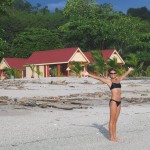
Photo: Jono Stevens
July/August, #27
“They always say, ‘Hurry the bus is leaving now!’ So you rush to get on the bus, hoping your luggage makes it to the top of the same rig, and wait for the driver to start the engine. It’s hot and you are crammed in tighter than a Tokyo subway. You wait and wait until you realize that time is metered entirely different here. Nothing is ‘on time,’ things just happen when they happen.”
—Melissa Stevens getting used to El Salvadoran time on her Central American surf odyssey with husband Jono Stevens
“The National Park Service is missing an opportunity. Because the Half Dome trail is the first wilderness experience for many hikers, it is an ideal place to teach backcountry etiquette – if we can summon the will and resources to do so.”
—John Yewell on the importance of proper trail etiquette for the growing crowds hiking Half Dome’s cable route
September/October, #28
“It’s just after midnight and I’m sandwiched between two Irish gals. It’s hot and there’s a lot of heavy breathing, squirming and giggling going on. But hedonistic our arrangement isn’t. We’re all fully dressed.”
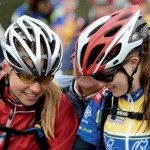
—Liam Gallagher travels to the Sierra on the legendary Green Tortoise bus
“In a country that tries to avoid walking whenever logistically possible, he lives to walk.” —Pete Gauvin on through-hiker Scott Williamson, who has hiked the Pacific Crest Trail seven times and was the first to yo-yo it in one season
November/December, #29
“Where is the no-pain-no-gain, survival-of-the-fittest-fastest-richest-and-most-popular-culture of team tryouts from my high school days? The formative experiences that inflated some egos and prematurely punctured others, sometimes turning kids off athletics altogether?”
—Kimberly Bird explores the surging popularity of high school mountain biking leagues in Northern California
| 2006 |
January/February, #30
“While eating my glistening fresh fruit, bragging how good it was, the old Aztec woman took a ladle of brackish water out of a soiled 5-gallon paint bucket under the table and proceeded to pour it over the fruit cups to keep them looking glossy.”
—Ian Elman learns that you can never be too careful with the food when you are traveling in Mexico
“Trekking up the Dur Chu, I learned one of my first trekking lessons: When hiking up a river valley, as beautiful as its waterfalls may be, you will soon be ascending. And the more spectacular the falls, the steeper the ascent will be.”
—First-time trekker Drew Miller gets trail wise in Bhutan
March/April, #31
“Leaving the security of solid rock for the thin air of the chasm makes even hardened climbers cringe.”
— Matt Johanson on Lost Arrow Spire’s famous Tyrolean traverse in Yosemite
May/June, #32
“Rather than tempt your maker with carefree disrespect, better to just suck it up and join the faithful throngs observing Cathedral’s congregation hours. Even with the crowds, you’ll still find plenty of granite enlightenment. Unlike surfers, climbers frown on dirty looks when racking up at the bottom.”
—Bruce Willey on the importance of getting an alpine start before climbing Tuolumne’s Cathedral Peak. The author was almost caught in a thunderstorm after getting a late start on the climb.
July/August, #33
“I remember when I first began adventuring solo many years ago. My father asked (more than once): “Aren’t you going to
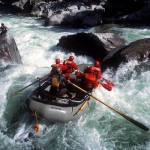
Photo: All-Outdoors, www.AORafting.com
carry a gun with you?” As any self-respecting daughter would do, I flexed my biceps and replied, “These guns!”
—Petit Pinson shares her passion for experiencing the wild solo, and encourages other women (and men) to do the same.
“You find yourself popping open a beer at the takeout and it tastes just a little better than normal. The sky seems a little bluer, the air crisper. You stand a little taller. And on Monday, back in the office, when your coworker asks about your weekend, you reply with a simple, “Good. Really good.” They wouldn’t understand anyway.”
—Geoff Jennings on California’s Class V classic, Cherry Creek
September/October, #34
“The echoed voice from the past of a cantankerous Shasta Mountain Guide telling me, ‘Step, kick, kick, plant your axe – rest!’ resonates as I come closer to the grail of 29,035 feet.”
—Robert Chang recall’s his Northern California roots on an ascent Everest
“Above all, going to surf camp as an adult is really, really fun. How many mornings are you stoked to get up early because you know you get to do something enjoyable all day? How often are your big responsibilities for the day re-applying sunscreen and rinsing out your wetsuit?”
—Maria Vitulli on the growing popularity of surf camps
| 2007 |
January/February, #35
“Some of the world’s best long-distance runners, the Tarahumara have been known to routinely run several hundred miles in five days during competitions or even just while getting around to perform everyday tasks – farther than I think I’ve ever biked in that time.”
— Karen Kefauver shares her mountain biking trip to Mexico’s rugged Copper Canyon, home to the indigenous Tarahmara people
“Witness a skier gracefully skating up a Sierra valley in half the time it would take a tele skier with climbing skins, and the discipline immediately entices.”
—Seth Lightcap reflect on how new backcountry skis restyle ancient Nordic discipline
March/April, #36
“With care and appropriate skill, there is nothing like the feeling in your gut as you approach the horizon line on a 20-foot waterfall.”
— Geoff Jennings shares the thrills of creek boating
“Turn by turn, section by section, dropping down the great white expanse, our efforts were rewarded.”
— Andrew Sawyer on spring skiing on Mt. Lassen
May/June, #37
“Pulled forward like a disobedient dog on a leash, my feet lost contact with my board and I was pitched headlong over the falls as the wave broke with a booming crash of whitewater.”
—Thomas S. Garlinghouse shares his surfing adventure in El Salvador’s “Wild East”
“On my knees, I take a final stroke and cut my hand on a rock just beneath the surface. It seems appropriate that I’ve given the ocean a piece of myself at the start and finish of my crossing. A toll, perhaps, for my successful passage?”
—Ryan Pingree’s reflections on the 32-mile QuicksilverEdition Molokai to Oahu Paddleboard Race.
July/August, #38
“The squirrely and somewhat unpredictable movement of the line is what makes slacklining the ultimate balance challenge.”
—Seth Lightcap on the history and current popularity of slacklining
September/October, #39
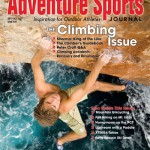 “If flatwater paddling is the equivalent of road biking, and whitewater paddling is more akin to mountain biking, upriver paddling might be the waterborne counterpart of cyclocross.”
“If flatwater paddling is the equivalent of road biking, and whitewater paddling is more akin to mountain biking, upriver paddling might be the waterborne counterpart of cyclocross.”
—Pete Gauvin behaves like a salmon while paddling a sea kayak upstream on the Sacramento River
“His refusal to rate his climbs and emphasize “chasing numbers” has inspired others to look for deeper meaning in the act of climbing.”
—Matt Niswonger on Chris Sharma’s deepwater soloing project in Mallorca, Spain.
November/December, #40
“Perhaps the most important thing to bring on a winter mountaineering trip is the right mindset. Don’t push for a peak in winter with an “at-all-costs” approach, which can backfire … The mountains will still be there whether you tag the top this time or next.”
—SP Parker gives tips on winter mountaineering and getting out in the “off” season.
“The climbing began with moderate climbing up fractured slabs, then quickly switched to exposed jamming and smearing. Many holds, cracks, and ledges were filled with snow. Several hundred feet above the talus slopes it became apparent that my only escape from the arete was up. The climber’s game had proven dangerously intoxicating once again.”
—Andrew Sawyer makes an impromptu free solo of the classic Sierra climb, the Swiss Arete.
| 2008 |
January/February, #41
“In addition to big fir planks and whisky-fed courage, there was one other key ingredient the miners needed for speed on the hill: Good dope.”
—Pete Gauvin on the history of “longboard” ski racing in the mining camps of the Northern Sierra and the concoction of racing wax applied to their 14-16 foot skis
“Climbing was an extension of backpacking. People came as backpackers that couldn’t get to the top of the peak. Nowadays they come from the climbing gym. So they don’t really have that deep-rooted feeling of love for the mountains already in place.”
—Bela Vadasz of Alpine Skills International shares how things have changed over his 30 years as a mountain guide
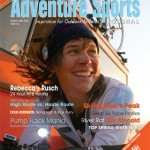 March/April, #42
March/April, #42
“By the time many California rafters and kayakers get into river mode, streams up and down the state are drying up and coming off the menu.”
—Pete Gauvin shares top spring river trips and reminds us to not let the runoff pass us by
“There were other pros in big trucks with their names painted on them and lots of logos. In contrast, I had brought my mom, my uncle, and a bike mechanic friend from home.”
—Rebecca Rusch makes the transition from professional adventure racer to 24-hour mountain biking
May/June, #43
“Part of the attraction to surfing is the fulfillment that comes from being part of a wild, untamed environment.”
—Ian Fein on the fear of sharks while surfing in the “Red Triangle”
“Indeed, stand-up has become the latest surf-inspired offshoot to grab a following, and it appears poised to last, as the reasons for its recent growth spurt go well beyond bare-chested celebrities. The practical, physical and sporting advantages of stand-up paddleboarding are numerous and compelling.”
—Ramona d’Viola explores the surging popularity of stand-up paddleboarding
July/August, #44
“There is something to be said for following your passion and donating your time to things you think will make a difference.”
— American Whitewater Stewardship Director Dave Steindorf of Chico shares his passion for protecting California’s rivers and providing public access
“If hang gliding and paragliding were a major sport you would have already heard of Kari Castle. Which is odd considering the sport’s extreme element. I mean strapping on a snowboard and launching ten feet in the air is one thing. Strapping yourself under some poles and fabric and flying off a hill only to catch some thermals and go up to an altitude that would scare the shit out of most birds is entirely another matter.”
—Bruce Willey introduces ASJ readers to record-setting, high-flying Kari Castle of Bishop
September/October, #45
“It is fine to race in California’s dust and sunshine, but I want to play in the mud, so we go for the rainy season.”
—David Gill, a cyclocross race organizer in Santa Cruz County
“Competition and cooperation. They are another of those big dualities we get to chew on. Like pride and humility. Like fear and desire. Climbing set them a stage, and alpine air encourages the rumination. How you play them out affects everything, from getting laid to the future of humanity.”
—Doug Robinson ponders the nature of alpinism in the High, and mild, Sierra
November/December, #46
“The sport wasn’t big enough to exclude anyone. The whole point was to persuade people to experience the satisfaction that comes from earning turns, not from the style of the turn.”
—Die-hard telemark skier Craig Dostie shares his decision to have his California-based publication, “Couloir,” be inclusive of all downhill disciplines, opening up the backcountry to a much wider audience
“We’re not telling anyone how to live their life. We’re just trying to show people a way to put adventure and fun back into snowboarding while respecting the environment.”
—Chris Edmunds of Leeward Cinema talks about his film “My Own Two Feet,” in which they turned their back on mechanized travel and hiked into the backcountry to get footage
| 2009 |
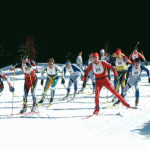
January/February, #47
“I was soon convinced that if I were to try the crossing, she certainly would be my choice of a companion. She changed my opinion that a woman’s place was definitely only in the home.”
—Dennis Jones first-hand account of his remarkable first ski crossing of Tioga Pass with “Miss” Milana Jank, a German alpinist and ski ambassador, in 1932
“However you ski The Great Ski Race, whether as a super-fast competitor or as a casual tourer, it is one of those community bonding events that you will enjoy year after year.”
—Mark Nadell shares the experience of the West’s largest cross-country ski race, The Great Ski Race from Tahoe City to Truckee
March/April, #48
“It wasn’t rocket science. You get an old bike and try to make it a little more useful in the dirt.”
— Mountain biking pioneer Charlie Kelly reflects on the evolution of off-road bikes
May/June, #49
“The reason people surf for 40 years or longer is because you don’t spend much time as a surfer on your feet riding waves. You almost never feel faded.”
— San Francisco surfer and author Matt Warshaw talks to ASJ about the surfing lifestyle
July/August, #50
“As I stood in the meadow watching my dog run through the tall grass, I thought to myself, I don’t know how much closer a person can get to heaven on earth than this.”
— Dave McNeill on hiking the Eastern Sierra high country above Bishop
September/October, #51
“On the one hand, there is this incredible danger. If you fall you are dead after you are 50 feet off the ground. But on the other hand you are completely safe if climbing within your limits. And there is the feeling that you are doing something you shouldn’t be doing—free soloing has that sort of intrigue.”
—John Bachar reflects on his sport just two weeks before falling to his death while free soloing the Dike Wall near Mammoth
“Originally, it began as an ambitious 2,500-mile off-road route from Montana to Mexico along the Continental Divide. But as the twirling globe slowed to a stop, our fingers ran all the way down the longest continguous mountain range in the world.”
—Jacob Thompson shares his epic pedal from Alaska to Patagonia down the backbone of the Americas
November/December, #52
“Few downhillers know what an adrenaline rush it can be flying down a narrow, winding trail on a couple lightning-fast skinny sticks.”
—Tim Hauserman from the article “Nordic Relief for Alpine Skiers,” on the misconceptions gravity-fed skiers have about cross-country skiing
| 2010 |
January/Februay, #53
“This is what we do for fun. We bundle ourselves up and head out into the elements enjoying its carefree pleasures and enduring its heaping shares of whoop-ass. And what better metaphorical experience – joy and laughter, discomfort and fear, struggles and uncertainty – could a newlywed couple embarking on a lifetime together have in one trip?”
—Wendy Lautner writes about her backcountry ski honeymoon in Patagonia
March/April, #54
“After a year of battling Stage Four cancer and enough infused chemo to light Las Vegas, I was in search of more strength. The leapin’ lizards, cherry gnarr-gnarr type that makes even the worst situations open into starbursts.”
—Robert Frohlich about his search for mojo at Glacier Point during his battle with cancer
“The challenge of steadying your shooting hand while gasping from race-pace Nordic skiing is like a doctor trying to operate after running up flights of stairs.”
—Seth Lightcap on the sport of biathlon and the new training center at Northstar

May/June, #55
“Being a practical middle-aged fellow I care no longer for foolish risks nor needless expense. I paddle the waters of Lake Tahoe every summer to celebrate my love affair with mountain life.”
—Robert Frohlich on kayaking Lake Tahoe, simple and care free
“Steamer Lane is like a surf auditorium built for show-offs. It breeds the worst in localism and the best in surfing acrobatics. Not surprisingly, the two often go together.”
—Jamal Yogis in an excerpt from his book, “Saltwater Buddha: A Surfer’s Quest to find Zen on the Sea”
July/August, #56
“Windsurfing is like dancing with a partner on a surfboard … Kiteboarding feels like you’re dancing solo on the board, hooked at the waist with a wind-powered umbilical cord.”
—Experienced windsurfer Craig Dostie in “It’s Not Sailing, It’s Flying,” about taking his first lessons in kiteboarding at the Delta
“The Oakland A’s gave him a tryout in 1973. Fortunately, his fastball wasn’t big-league material and he realized his fortunes were more likely to be determined by his ability to deliver a deft sentence than a strike on the outside corner.”
— Pete Gauvin on prolific San Francisco newspaper columnist and guidebook author Tom Stienstra
September/October, #57
“John was killed on a Highway 395 after hitting a deer on his motorcycle on his way to climb Excelsior Mountain … Too often it’s not the mountains that take good mountaineers but just getting to them.”
—A remembrance of John Fischer (1946-2010), noted climber and owner of the Palisade School of Mountaineering, by Bruce Willey
November/January, #58
“So if not full circle, at least I’ve come a long ways. And that’s why they call it practicing rather than doing yoga. It’s the process that counts. The results are just a by-product.”
—After years of denial and protestation, climber Bruce Willey finally comes to terms with yoga in his piece, “The Reluctant Yogi”
“The Brissendens persevered and not only rebuilt Sorensen’s, but also helped rescue Hope Valley from future development. … In 1985, along with other local activists, they helped create the Friends of Hope Valley. The nonprofit helped to preserve 25,000 acres of open space in Hope Valley and eastern Alpine County through the Trust for Public Land.”
—The late Robert Frohlich recounts the history of a favorite Sierra getaway, Sorensen’s Resort. “Fro” passed away in October from cancer.
“It doesn’t take very long for dedicated Tahoe ski bums to hear the stories from the many skiers and riders who use Squaw as training ground for the bigger, wilder terrain in Alaska. I knew I had to go, but how was I going to afford the trip?”
—Brennan Lagasse on the seeds of his mission to leave ski tracks on each of the world’s seven continents
| 2011 |
February/March, #59
“Dozens of wild haired, loose souls began settling in South Lake Tahoe. Once they got there, they did whatever the hell they wanted. They twirled on skis and practiced precision mogul turns. They built jumps, did back flips, puffed on joints and did more back flips.”
—Jeremy Evans on the golden age of ski bumming at Heavenly
“Give me the long steady hills and even the flats, but my chicken feathers flutter on the downhills. When I see a sign that says 12% grade, I put on the brakes and feel the breeze of dozens of riders roaring past.”
—Tim Hauserman enjoys the Chico Wildflower Century as a rookie over the age of 50

